Section Three, Aquinas
0001 Armand Maurer publishes a short paper tracing a path, through time, of the idea of secondary and primary causes. I follow the timeline, which starts in section three.
Around two decades after the death of the seventh Abbasid caliph, al-Ma’mun, in 6633 U0’, someone puts pen to paper. Centuries later, when the Book of Causes is translated into Latin, some medieval scholastics assume that this “someone” is Aristotle. Thomas Aquinas writes a commentary on the work.
0003 The irony?
Al Ma’mun’s story as caliph calls to mind our world, in the 7800s.
First, al Ma’mun tries to directly reconcile Sunni and Shi’a branches of Islam. This approach dramatically fails within his lifetime.
Second, during his remaining 15 years, he tries an indirect reconciliation by promoting Islamic thinkers familiar with the rationalist methods of ancient Greek and Hellenistic philosophers. He encourages translations from Greek into Arabic. He promotes an academy called, “The House of Wisdom”, in Baghdad. Again, this approach fails. Many of his subjects refuse to believe that the Qur’an is a “created” work.
Thus, the Book of Causes may address a question relevant to our time.
Could the the Qur’an be ascribed to secondary causation, in concert with a primary cause, God’s Will and Presence?
0004 Here is how this might look as a category-based nested form. See required reading.
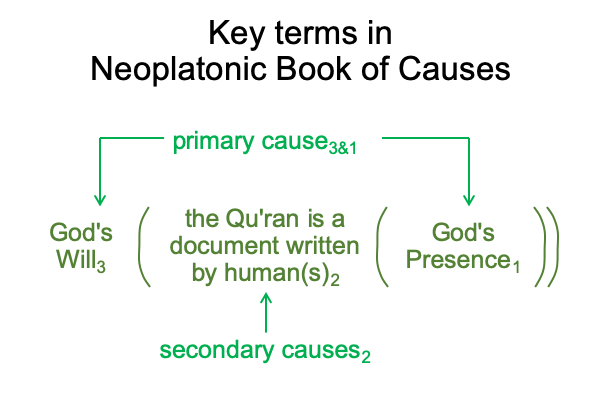
Note that God’s Presence1 is the potential underlying the normal context of God’s Will3.
0005 Okay, on to Thomas Aquinas (7025-7074 U0’).
In 7068, he notices a similarity between The Book of Causes and a newly translated work, The Elements of Theology, by Neoplatonist Proclus (6210-6285 U0’). This suggests that the idea of primary and secondary causation is much older than the Arabic translation of The Book of Causes.
0006 What does Aquinas say about The Book of Causes?
He focuses on two propositions (A and B).
0007 First (A), primary cause has greater impact than secondary cause.
Thomas notes (more or less), “This is true for God as a primary cause. God causes being to exist.”
The Latin term, ‘esse’, refers to being as existent, in contrast to “ens”, being as being.
God may bring things into being (esse) from nothing, that is, without a pre-existing ens.
Otherwise, God creates ens, being as being, then ens enters form and becomes esse, being as existent.
The pattern of ens preceding esse appears in the Genesis Creation Story. On several days, God says, “Let there be (ens)…” and then, the earth brings forth, (esse).
In this, the earth has the power to bring forth.
These powers go with secondary causation.
0008 Second (B), we see causes in the nature of things.
Things have their own powers. These are not the powers of the Divine. Rather, these are particular powers, characteristic of the substance of each creature. These powers specify one or another outcome. They are called, “secondary causes”.
0009 These two propositions, A and B, associate to a nested form in the following manner.
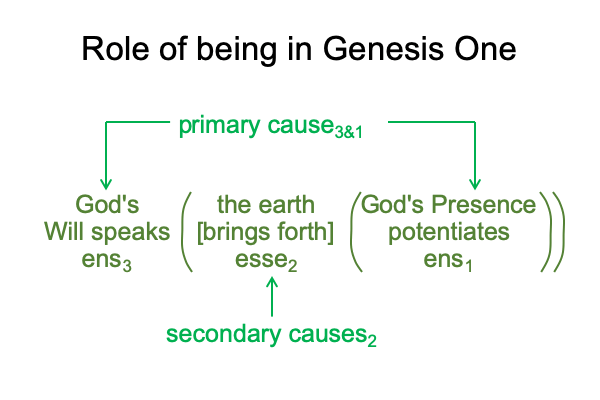
0010 The actuality is dyadic. This is typical in the category of secondness. Secondness consists of two contiguous real elements. In the above notation, one real element [is contiguous with] another real element. The contiguity is placed in brackets. The contiguity bears the marks of causality.
There is a certain circularity to this actuality. The earth holds creatures, even though it brings creatures forth as existent beings. Existent beings that the earth brings forth participate in the earth’s powers, once they are present. So, as the earth brings forth, the earth appears to increase in its powers. Each additional type of creature adds to the capacities of the earth. When a type of creature disappears, the earth loses the power to make that specific creature.
Does that sound sufficiently circular?
0011 Compare this circularity to the following example of secondary causation.
Consider a pen.
A pen cannot write a note to a my friend.
Instead, the pen is an instrument for me, the writer.
So, if I am going to be a writer, I better acquire a pen.
0012 The writer and the note constitute a dyad. The writer is a real element. The letter is a real element. The pen is the instrument that brings the two real elements together. Is it not curious that the word, “pen”, is also a verb?
Here is a picture of this actuality.
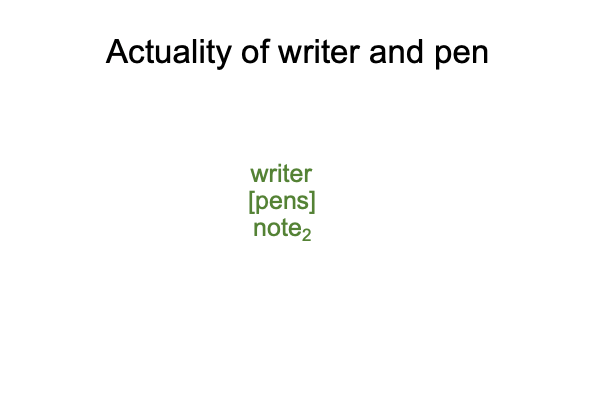
0013 The pen is an instrument. The actuality2 has been alchemically isolated from its nested form. So, no one can determine the aims and designs of the note.
Here I may ask, “Does the instrumentality of the pen account for the realness of the writer and the note?”
Of course, a scientist may reply, “If I observe the writer and all the notes that the writer produces, then I can generate a mechanical model accounting the use of a pen, and publish the results in the Empirical Journal of Pens.”
In short, the scientist focuses on actuality2.
0014 However, the instrumental causality of the pen occurs within the actuality2 itself. It offers no clue to the question that everyone asks.
Why is the writer penning a letter?
Material, final and formal cuases address this question. Once answers come to light, the actuality2 is no longer alone. It participates in a category-based nested form.
0015 Here is a picture of the way that Aristotle’s four causes, starting from within actuality2, intimate normal context3 and potential1.
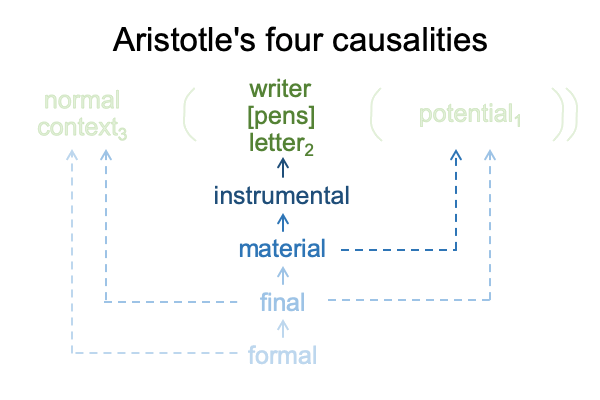
0016 What does this imply (C and D)?
0017 Instrumental causes are secondary causes (C), without the primary cause.
Consequently, I anticipate that instrumental causes may be confounded with secondary causes.
In the above example, the scientist does this. The scientist focuses on the instrumental and material causality of the pento the exclusion of final and formal causes for the writer and note.
0018 Aristotle’s remaining four causes (D) construct a nested form around a dyad in actuality.
Material causes link actuality2 to the possibility of ‘something’1.
Final causes connects the actuality2 to both normal context3 and potential1.
In this example, the writer [pens] a letter2 occurs in a particular normal context3, say, remembering an old friend3. Plus, there is an incentive to say ‘something’1, recalling a fond memory.
Formal causes draw the writer to compose the note2 in a certain style, suitable for conveying a particular mood.
0019 Here is how that looks.
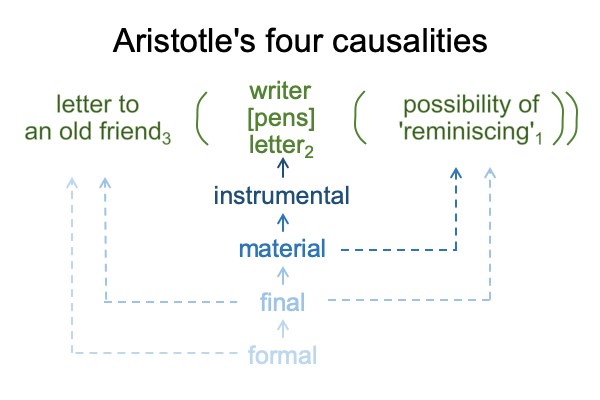
0020 Overall, Aristotle’s four causes are neither secondary or primary causes. Rather, they draw a creaturely power (the power of the pen) into its corresponding category-based nested form. This corresponds to a transition from instrumental to secondary cause2, as well as a transition from the remaining causes to elements that point to a primary cause3,1.
0021 Are these surprising claims?
Consider a thing2 or event2.
How do Aristotle’s four causes come into play?
When we explore its instrumental causes, actuality may become a dyad in secondness. Secondness consists of two contiguous real elements.
When we look at its2 material causality, potential1 comes into consciousness.
When we consider final attributes. Potential1 is clarified. Normal context3 comes to consciousness.
When we think about formal requirements and design, normal context3 is clarified.
Secondary causality associates to actuality2 in a category-based nested form.
Primary causality associates to normal context3 and potential1 in a category-based nested form.
0022 At the time of Thomas Aquinas, several philosophical schools argue that secondary causes detract from the idea that all causation rests in God. So, actuality2 is just a residue of the divine.
Aquinas argues against this proposition, saying that this point of view reduces the dignity of the creature and by extension, God’s creation.
If the Ash’arite school is correct, then the creature cannot be responsible for its own actions. Only God is responsible.
If creatures are not responsible, then why do they take care of themselves so well?
If the claims of Bonaventure and his followers are correct, and secondary causes are not sufficient, then how do creatures get along in the world?
Indeed, they get along so well that the seem designed to do what they do.
0023 Aquinas never envisions that the word, “adaptation”, could replace the word, “design”. Why? Aquinas lives in the enternal now. Species of plant and animal are always the same. Each bears according to its kind.
